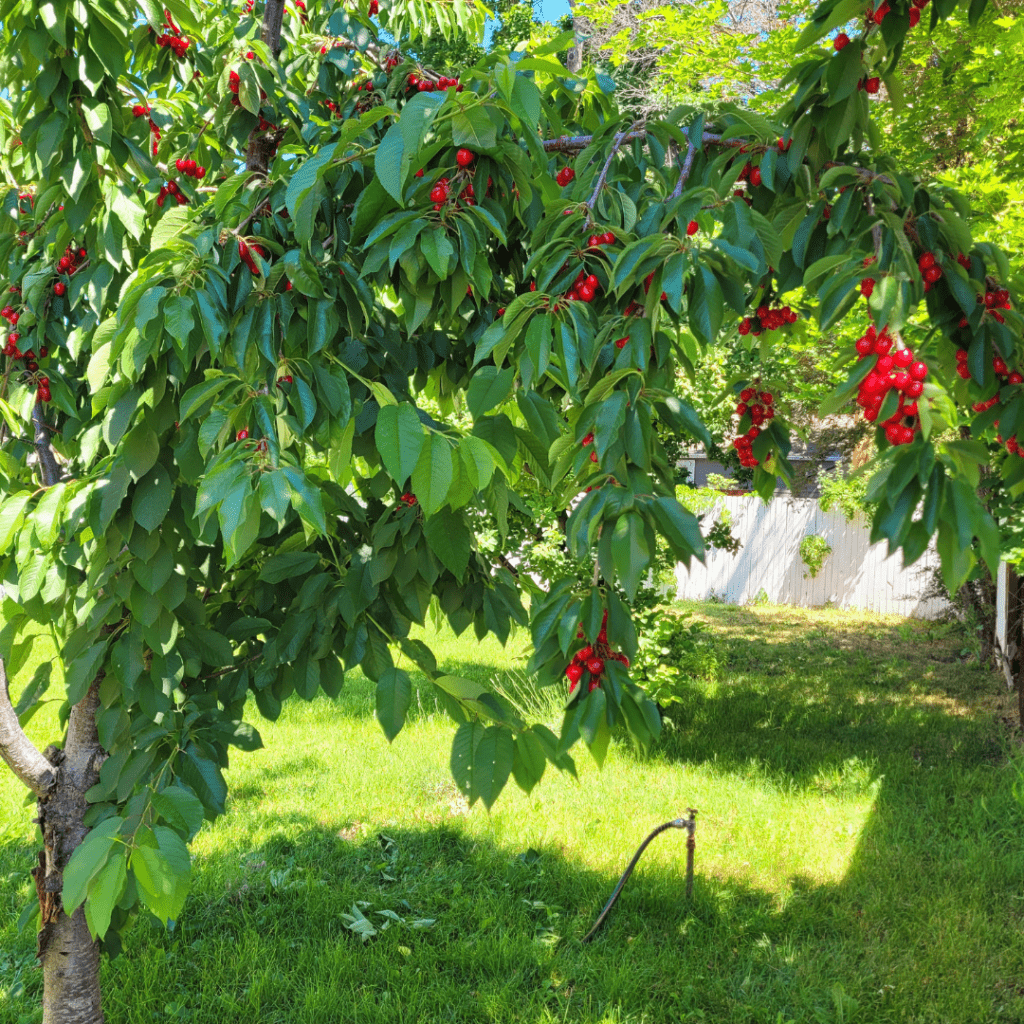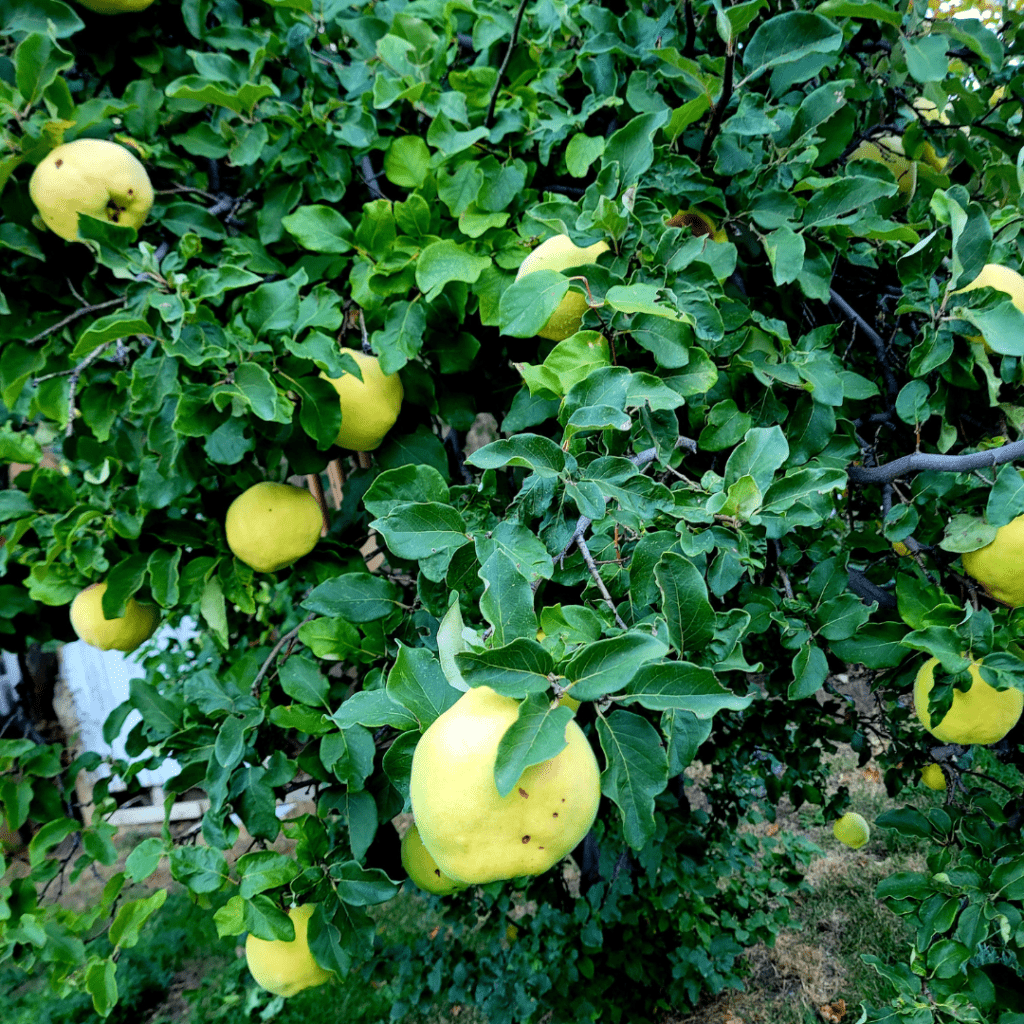Learn how to design your backyard orchard for maximum yield with smart planning, proper tree spacing, and strategic plant selection. This guide covers essential tips for choosing the right fruit tree varieties, arranging them for optimal sunlight and airflow, and incorporating companion planting to boost productivity. Whether you have a small garden or a larger space, these proven techniques will help you create a thriving orchard that produces abundant, healthy fruit year after year.
Designing a backyard orchard that truly thrives isn’t just about planting a bunch of fruit trees and hoping for the best. It’s about thoughtful planning—making sure each tree has enough room to grow, gets plenty of sunlight, and plays nicely with its neighbors. Out here off-grid, every inch of garden space counts, so designing for maximum yield means working smarter, not harder.
In this post, I’ll share how I plan and arrange my orchard to get the most fruit possible from my space, including tips on tree placement, variety selection, and companion planting. Whether you’ve got a tiny backyard or a spacious garden, these ideas will help you turn your orchard dreams into a bountiful reality.
This is a pinnable post. Tap or hover over any image in this post to pin to your Pinterest Boards.
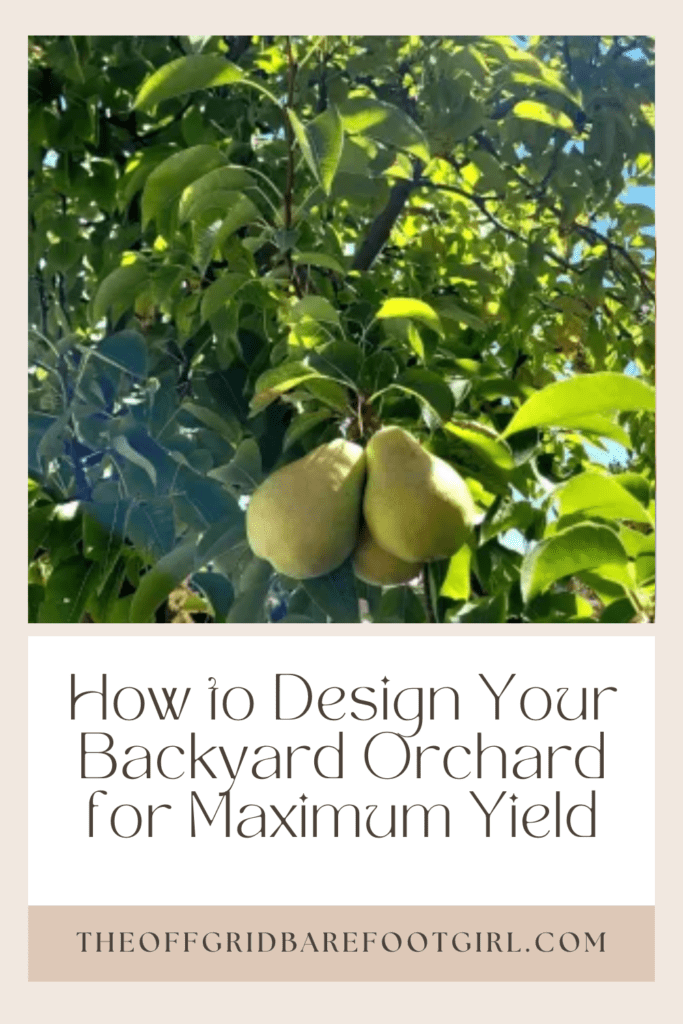
Choosing the Right Fruit Trees for Your Backyard Orchard
Factors to Consider When Selecting Fruit Trees
When it comes to choosing fruit trees for your backyard orchard, there are a few factors to consider. First and foremost, think about what fruits you and your family actually enjoy eating. Sure, that alluring dragon fruit might sound cool, but if nobody in your house likes the taste, it’s probably not the best choice. Consider the climate and growing conditions in your area, as certain fruits thrive better in specific regions. And don’t forget about maintenance – some fruit trees require more care and attention than others. Choose trees that fit your lifestyle and level of commitment.
My family loves cherries, pears, and strawberries, so that is what I am growing in my very own backyard orchard. I am also growing a quince tree that was already planted on this little property, and I am adoring it! My quince tree is the most gorgeous tree in the spring with all of its pretty blossoms. The quince fruit is delicious and makes a wonderful jam! Also, quince fruit is perfect for canning my own liquid pectin for other canning projects, eliminating the need to purchase pectin from the grocery store, so I can can up a ton of strawberry jam!
Assessing Climate and Hardiness Zones
While dreaming of tropical delights is fun, it’s important to be realistic about your climate. Check your hardiness zone to determine which fruit trees will be most successful in your area. Remember, fruit trees can be a bit sensitive to extreme temperatures, so it’s crucial to choose varieties that can handle the highs and lows of your region. If you’re determined to grow something a bit out of your zone, be prepared to provide some extra TLC to protect your precious trees from the elements.
Understanding Pollination Requirements
Did you know that some fruit trees have the superpower ability to pollinate themselves? It’s true! These self-pollinating fruit trees are like the superheroes of the plant kingdom. They don’t need a partner tree nearby to produce delicious fruits because their flowers have both male and female parts, making them capable of fertilizing themselves. This means they can set fruit without relying on bees or other pollinators to transfer pollen from one flower to another. Self-pollinating trees offer gardeners a huge advantage as they save space in the garden and eliminate the need for multiple trees of the same species.
So, if you’re keen on growing your own fruit, but have limited space or lack neighboring gardens, fret not! You can still enjoy healthy, homegrown peaches, apples, or cherries thanks to these remarkable self-pollinating wonders. Here’s a list of some common self-pollinating fruit trees:
- Apple (some varieties): While many apple varieties benefit from cross-pollination, some are self-pollinating, such as ‘Golden Delicious’ and ‘Granny Smith.’
- Apricot: Most apricot trees are self-pollinating.
- Cherry (some varieties): Sweet cherry varieties such as ‘Stella’ are known to be self-pollinating. This is what I have in my orchard and I love it!
- Fig: Figs are generally self-pollinating.
- Nectarine: Most nectarine trees are self-pollinating.
- Peach: Many peach varieties are self-pollinating.
- Plum (some varieties): European plum varieties like ‘Stanley’ are often self-pollinating, while Japanese plums may benefit from cross-pollination.
- Pomegranate: Pomegranate trees are usually self-pollinating.
- Persimmon (some varieties): Certain persimmon varieties, like ‘Fuyu,’ are self-pollinating.
- Quince: Quince trees are often self-pollinating. This is what I have in my orchard and I love it!
- Pear (some varieties): Some pear tree varieties are self-pollinating like the Bartlett. This is what I have in my orchard and I love it!
It’s essential to note that while these trees are primarily self-pollinating, having multiple trees or encouraging pollinators in your garden can still improve fruit production. Additionally, factors such as climate, location, and specific cultivars can affect the success of self-pollination. Always check with local nurseries or agricultural extension offices for advice tailored to your specific growing conditions.
Planning the Layout and Spacing of Fruit Trees
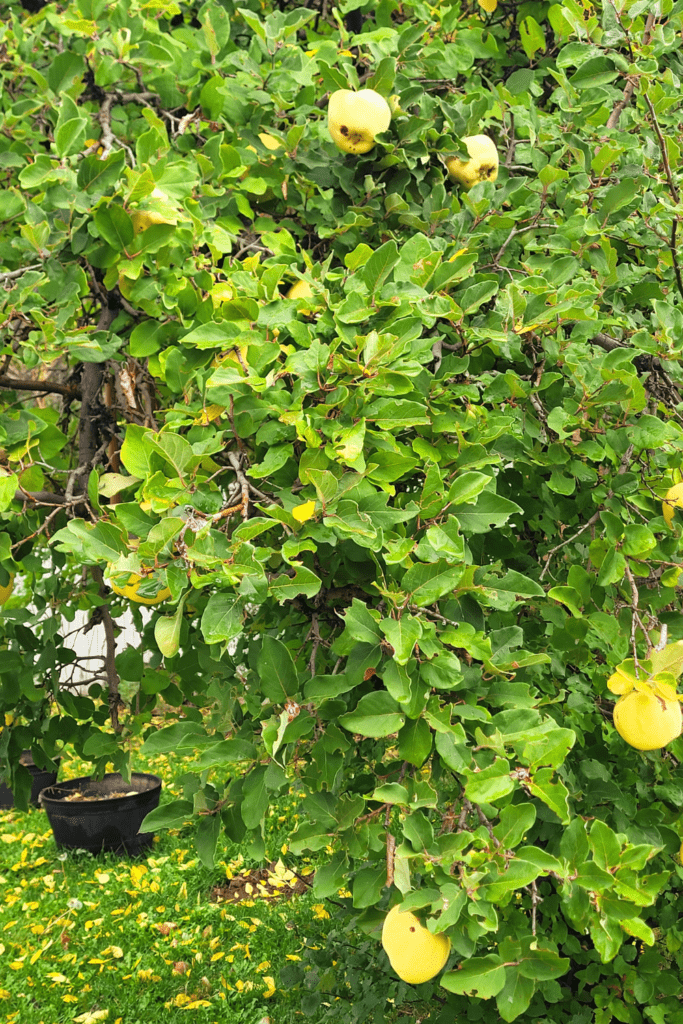
Determining Orchard Size and Shape
When planning your backyard orchard, think about how much space you have and what shape will work best for your needs. Consider the size of the mature trees and leave enough room for them to spread their branches without invading each other’s personal space. My fruit trees are all lined up in a single file and spaced nicely apart along my fence line on one side of my yard.
Proper Spacing for Fruit Trees
Give your fruit trees the personal space they deserve. Proper spacing ensures that each tree gets enough sunlight, airflow, and nutrients to thrive. Nobody wants their trees to feel crowded and claustrophobic, right? Consult a spacing guide for your specific fruit trees to avoid any awkward encounters between their branches.
Companion Planting and Interplanting Options
For a backyard orchard filled with diversity and character, consider companion planting and interplanting. Certain plants, like herbs and flowers, can help control pests, attract beneficial insects, or provide shade. Plus, it adds a touch of personality to your orchard. My backyard orchard is filled with 3 gorgeous phenomenon lavender bushes, a chamomile patch, and a barrel of spearmint (gotta keep those suckers contained!) I will be adding more herbs to my orchard this year!
Understanding and Implementing Proper Pruning Techniques
Pruning Basics for Fruit Trees
Pruning is like giving your trees a much-needed haircut. It helps maintain their shape, promotes healthy growth, and reduces the risk of disease. Start by removing any dead or damaged branches, then thin out crowded areas to improve airflow – think of it as your tree’s own personal spa day. Just be careful not to go overboard and accidentally give your trees a buzz cut. They might never forgive you.
Pruning Different Types of Fruit Trees
Different fruit trees have different pruning preferences. Some like to be pruned in winter, while others prefer a summer trim. Some enjoy a light shaping, while others need a more drastic haircut. Get to know the specific requirements of each type of tree in your orchard, and approach your pruning sessions with confidence.
Training Young Trees for Optimal Growth and Structure
Young trees are like impressionable teenagers – they need guidance, structure, and a little tough love. Train them early on to develop a strong and sturdy framework. Prune away any competing branches. With proper training, your young trees will grow up to be proud, productive members of your orchard community.
Enhancing Soil Health and Nutrient Management
Soil Testing and Analysis
Before you start showering your trees with fertilizer, it’s crucial to understand the soil they’re rooted in. Get a soil test done to assess its pH level, nutrient composition, and overall health. This will help you make informed decisions about soil amendments and fertilizers. I have a separate post with 4 DIY garden soil tests you can perform at home. If you have sandy soil and need help, I have a post for that too. Sandy soil for fruit trees is not good since it drains way too fast, leaving no hydration for the roots, and it can cause the tree to topple over in a wind storm since sandy soil is not compacted enough. Just ask my poor leaning mailbox whose post is buried in sandy soil. I need to fix that! Therefore, you don’t want your fruit trees to lean either!
I will be using concrete for my mailbox post project. Don’t use concrete for your fruit tree’s stability hahaha! Just kidding, I know you won’t do that! … Let’s move on.
- 4 Easy DIY Garden Soil Tests to Do Now
- How to Fix Sandy Garden Soil with These Effective Organic Amendments
Organic Soil Amendment Options
When it comes to soil amendments, organic options are the hippest choice. Compost, aged manure, and natural mulch are like the cool kids of the soil world. They improve soil structure, provide essential nutrients, and help retain moisture. Plus, they’re eco-friendly and won’t fill your orchard with questionable chemicals. Your trees will thank you for being an organic trendsetter. If you want to get started in composting, I have some posts to help you get started. Plus, you can even compost indoors!
- Clever Ways to Incorporate Indoor Composting into Your Home
- How to Start Composting for the Garden: A Step-by-Step Guide
- The Ultimate Guide to Composting in Your Suburban Backyard
Fertilizer Application and Timing
Even trees need a little extra boost sometimes. Choose a fertilizer specifically formulated for fruit trees and follow the recommended application rates. Be mindful of timing – feeding your trees during their active growing season will ensure they have the energy to produce mouthwatering fruits. Just don’t forget to read the instructions. Adding 10 times the recommended dose won’t magically turn your trees into fruit-producing machines.
Incorporating Integrated Pest Management Strategies for Orchard Success
Identifying Common Orchard Pests and Diseases
When you have an orchard, you become the ruler of your own fruity kingdom. But just like any kingdom, there are pests and diseases lurking around, ready to launch an attack on your delicious fruits. It’s important to know your enemy, so take some time to identify the common pests and diseases that might trouble your orchard. Whether it’s aphids, codling moths, fruit flies, or a pesky fungus, understanding what you’re up against will help you come up with a solid defense plan.
Natural and Biological Pest Control Methods
Now that you know your foes, it’s time to fight back. But let’s do it in an eco-friendly way. Embrace the power of natural and biological pest control methods. Get yourself some beneficial insects like ladybugs or lacewings that will happily chow down on those pesky aphids. Use neem oil or insecticidal soap to zap any unwanted visitors. Remember, you’re creating a balanced ecosystem in your backyard, not a war zone.
Monitoring and Preventive Measures
Prevention is always better than dealing with a full-blown invasion. Keep a watchful eye on your orchard and regularly inspect your trees for signs of trouble. Set up traps to catch any pests before they can multiply. Implement preventive measures like pruning off infected branches, cleaning up fallen fruit, and providing adequate spacing between trees to allow for proper airflow. By staying vigilant and taking action when necessary, you’ll nip those problems in the bud.
Ensuring Adequate Irrigation and Watering Practices
Determining Water Needs for Fruit Trees
Determining the water needs of your trees is crucial for their health and productivity. Different trees have different preferences, so do a little research or consult a horticulturist to figure out how much water your specific fruit trees require. Factors like climate, soil type, and the age of the tree will all play a role in determining the perfect hydration levels.
Irrigation Systems and Methods
Now that you know how much water your trees need, it’s time to deliver it efficiently. There are various irrigation systems and methods to choose from, ranging from simple soaker hoses to fancy drip irrigation systems. Consider factors like water efficiency, ease of use, and your personal budget when selecting the system that works best for you. Just remember, your goal is to keep those fruit trees happy and hydrated, not create a water park.
Watering Schedule and Efficiency
Consistency is key when it comes to watering your orchard. Develop a watering schedule that meets the needs of your trees without drowning them. Water deeply and infrequently, allowing the soil to dry out slightly between waterings. Mulching around the base of your trees will help retain moisture and prevent weed competition. Oh, and don’t forget to check the weather forecast. Mother Nature might help out with some natural irrigation, saving you a job or two.
Maximizing Pollination and Fruit Set in Your Orchard
Understanding Pollinators and Their Role
Nature has this magical way of making things happen, and when it comes to fruit trees, pollinators play a vital role. Bees, butterflies, and other pollinators are the superheroes of your orchard, ensuring that flowers transform into fruits. Take the time to understand their importance and the role they play in the pollination process. They deserve a standing ovation for their hard work!
Attracting and Supporting Pollinators
Now that you appreciate your pollinator friends, it’s time to roll out the welcome mat. Create a pollinator-friendly environment in your backyard orchard by planting flowers that attract bees and butterflies. Provide nesting areas and water sources for them to stay hydrated. Avoid using pesticides that can harm these beneficial creatures. Trust me, they’ll appreciate your efforts and repay you with abundant fruits.
Pollination Techniques for Improved Fruit Set
Sometimes, you need to lend a helping hand to ensure the best fruit set possible. If your orchard is not receiving enough visits from pollinators, you can try manual pollination techniques. Use a small brush or Q-tip to transfer pollen from one flower to another. Pretend you’re a bee, minus the wings and buzzing sound.
Harvesting and Maintaining the Orchard for Long-Term Yield
Timing and Techniques
The moment you’ve been waiting for has finally arrived – harvest time! But before you start plucking fruits left and right like a fruit-crazed maniac, understanding the timing and techniques for harvesting is essential. Each fruit has its own signals of readiness, whether it’s color, firmness, or aroma. Learn these signs and harvest at the right time to ensure you enjoy the most delicious and ripest fruits from your backyard orchard.
What I love about my orchard is that I have time between harvesting each tree. For instance, the cherry tree is the first tree to harvest just in time for the 4th of July! I can preserve and can all types of delicious cherry recipes. This allows me plenty of time before I have to harvest my pear tree at the end of summer. I then can focus on canning pear sauce or pear butter or a new pear recipe. Once pear season is over, it will be time to harvest and preserve my quince tree. Think of timing when you plant your orchard. This is less stress and easier for me to manage when the harvest seasons of each fruit tree is spaced out! Trust me on this one!
Conclusion
By following the guidelines and techniques outlined in this article, you can create a backyard orchard that not only adds beauty to your landscape, but also provides you with a plentiful supply of fresh, flavorful fruits. Remember to regularly maintain and care for your orchard, adapting to the changing needs of your trees throughout the seasons. With patience and dedication, your efforts will be rewarded with a fruitful harvest year after year. So go ahead and start designing your backyard orchard for maximum yield – it’s a rewarding and delicious adventure waiting to happen!
Learn more about growing a sustainable backyard orchard in my other posts!
- How to Grow a Sustainable Backyard Orchard
- Why You Need to Start Micro-Orcharding in Your Backyard
- All About Apple Trees: Ultimate Guide
- Surprising Benefits of Growing Garlic Around Your Fruit Trees
- All About Cherry Trees: Ultimate Guide
- All About Quince Trees: Ultimate Guide
Want More Fruit from Your Trees? Let Me Show You How

Companion planting is just the beginning. If you’re ready to build a thriving backyard orchard that feeds your family and nourishes your soil, you’ll love my book Harvesting Paradise: Your Guide to Growing a Backyard Orchard. Inside, I share everything I’ve learned—step by barefoot step—about planting, pruning, and creating an off-grid oasis filled with apples, pears, cherries, and more. Grab your copy and start turning your land into a self-sufficient fruit haven today!
Get your copy!
Harvesting Paradise: Your Guide To Growing a Backyard Orchard
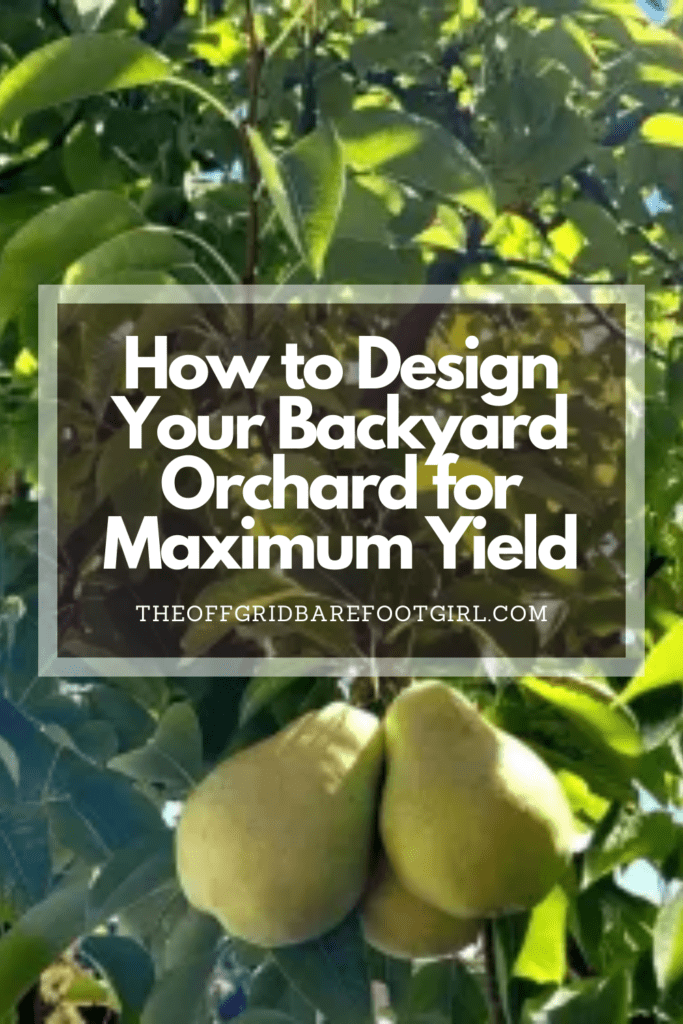
Frequently Asked Questions
1. How many fruit trees can I plant in my backyard orchard?
There is no one-size-fits-all answer to this question as it depends on the size of your yard, the available space, and the types of fruit trees you intend to plant. However, as a general guideline, fruit trees should be spaced about 10 to 15 feet apart to allow for adequate sunlight, airflow, and root development. Consider the mature size of the trees and plan accordingly to ensure enough space for each tree to thrive.
2. Do I need to have different varieties of fruit trees for cross-pollination?
For some fruit trees, cross-pollination between different varieties is necessary to ensure optimal fruit set. Examples include apples, pears, and cherries. However, not all fruit trees require cross-pollination. Some varieties are self-pollinating, meaning they can produce fruit on their own. It’s important to research the specific pollination requirements of the fruit trees you plan to grow and ensure you have compatible varieties for successful pollination and fruit production.
3. How often should I water my backyard orchard?
The watering needs of your backyard orchard will depend on various factors such as the type of soil, weather conditions, and the age of the trees. Generally, fruit trees require regular watering, especially during hot, dry periods. Young trees need more frequent watering compared to established ones. Aim to provide about 1 to 1.5 inches of water per week through irrigation or rainfall, ensuring the water reaches the deep root zone of the trees.
4. How can I protect my orchard from pests and diseases?
Implementing integrated pest management strategies is key to minimizing pest and disease issues in your orchard. This includes practices such as regular monitoring, proper sanitation, promoting natural predators, using organic pest control methods when necessary, and maintaining overall tree health. Additionally, choosing disease-resistant and pest-tolerant varieties can help reduce the need for chemical interventions. It’s important to stay informed about common orchard pests and diseases in your area and take proactive measures to prevent and address any issues that may arise.
Summary
I hope I have inspired you to grow your own permaculture garden.
If you were encouraged by this post, I invite you to check out my FREE Printables Page for fun free printables, planners, and charts.
ENTER MY FREE Printables Page HERE
I invite you to check out some more of my posts!
How to Build a Dollar Tree Strawberry Tower
How to Propagate and Grow Grapes
Your Ultimate Guide to a Permaculture Garden
How to Grow Concord Grapes In Your Backyard
How to Start a Backyard Orchard: A Beginner’s Guide
All About Cherry Plum Trees: Ultimate Guide
How Persimmon Fruit Trees Can Change Your Life! Unbelievable!
How to Design Your Backyard Orchard for Maximum Yield
How to Grow a Sustainable Backyard Orchard
Surprising Benefits of Growing Garlic Around Your Fruit Trees
How to Can a Year’s Supply of Quince Jam
Pears: All About Pear Trees: Ultimate Guide
Cherries: All About Cherry Trees: Ultimate Guide
Quince: All About Quince Trees: Ultimate Guide
Apples: All About Apple Trees: Ultimate Guide
How to Grow a Productive Perennial Raspberry Patch
Why You Need to Start Micro-Orcharding in Your Backyard
How to Grow a Productive Perennial Strawberry Patch
Blessings,
The Off Grid Barefoot Girl



